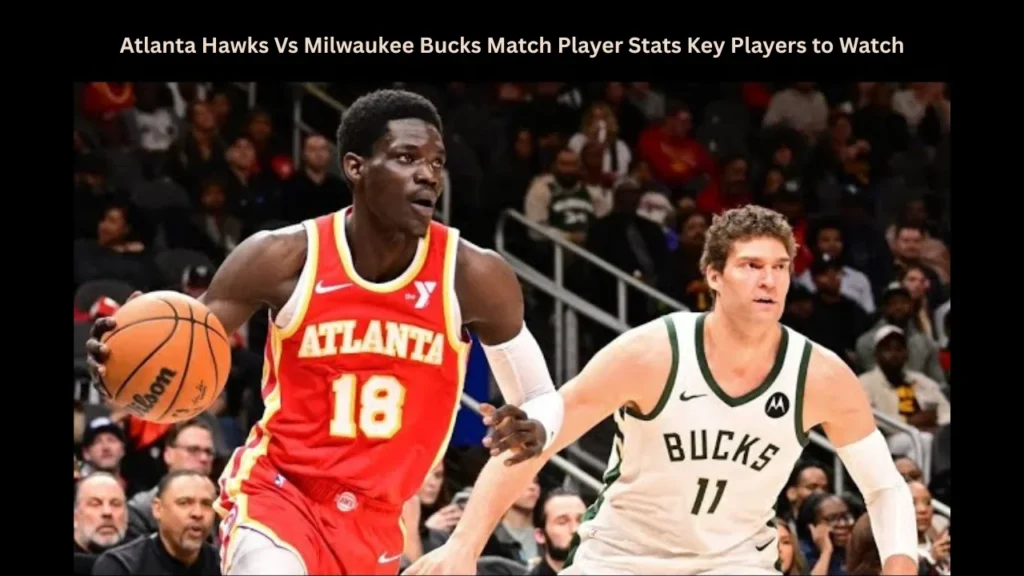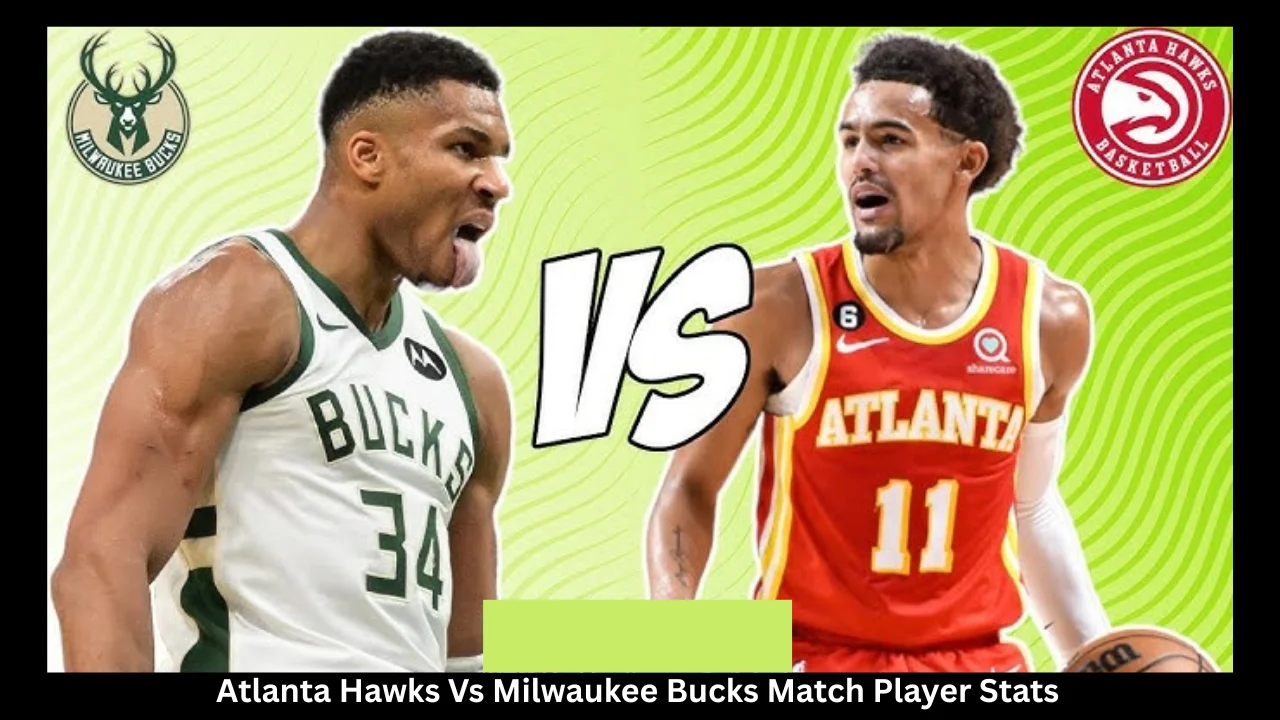Basketball fans love the thrill of close contests, and one of the most anticipated rivalries in the Eastern Conference is the Atlanta Hawks against the Milwaukee Bucks. Every time these teams clash, the game is packed with excitement, standout performances, and unforgettable highlights. This article takes a deep dive into the Atlanta Hawks vs Milwaukee Bucks match player stats, exploring how the stars of each side contribute to the outcome, what the numbers tell us, and why this matchup always grabs attention.
The Importance of Match Player Stats
In modern basketball, statistics are more than just numbers. They reveal trends, strengths, and weaknesses that define a game. Looking closely at Atlanta Hawks vs Milwaukee Bucks match player stats provides insights into shooting efficiency, defensive power, rebounding battles, and assist creation. These figures help fans, coaches, and analysts understand not just who won but why a particular team dominated.
ALSO READ: Charity Nye A Life of Privacy Behind a Famous Name
Head-to-Head Team Background
The Atlanta Hawks and Milwaukee Bucks have faced each other countless times across decades of NBA history. While the Bucks have often been led by superstar talent like Giannis Antetokounmpo, the Hawks counter with young stars such as Trae Young. The Atlanta Hawks vs Milwaukee Bucks match player stats often highlight the contrast between Milwaukee’s size and power against Atlanta’s speed and perimeter shooting.
Atlanta Hawks Vs Milwaukee Bucks Match Player Stats Key Players to Watch

Trae Young – Atlanta Hawks
Trae Young is the heartbeat of the Hawks’ offense. Known for his long-range shooting and playmaking, his assists and points often decide whether Atlanta can keep pace with Milwaukee’s interior dominance.
Dejounte Murray – Atlanta Hawks
Murray adds balance with his defensive intensity and ability to score inside. His steals and fast-break opportunities can swing momentum quickly.
ALSO REAAD: Mastering the Power of Gimkit Host A Comprehensive Guide to Engagement and Education
Giannis Antetokounmpo – Milwaukee Bucks
Giannis is a force of nature. Rebounds, points in the paint, blocks, and assists make him one of the most complete players in the NBA. His dominance in Atlanta Hawks vs Milwaukee Bucks match player stats is always visible.
Damian Lillard – Milwaukee Bucks
Since joining the Bucks, Lillard has added outside shooting and clutch scoring. His three-pointers and free-throw consistency bring an extra dimension to Milwaukee’s offense.
Offensive Performance Analysis
When breaking down Atlanta Hawks vs Milwaukee Bucks match player stats, offense stands out as a decisive factor.
- Hawks: Their offense revolves around spacing the floor and creating opportunities for shooters. Trae Young’s assists per game often surpass double digits, reflecting Atlanta’s ball movement.
- Bucks: Milwaukee thrives in the paint, with Giannis attacking the rim and Lillard stretching defenses from beyond the arc. Their field goal percentage in these games tends to be higher because of balanced inside-out scoring.
Defensive Matchups and Stats
Defense often decides tight games.
- Hawks’ Defense: They rely heavily on Murray’s perimeter defense, Capela’s rim protection, and team rotations. Their block and steal numbers must be high to slow down Milwaukee.
- Bucks’ Defense: Giannis and Brook Lopez anchor the paint, while Lillard applies pressure on ball handlers. Milwaukee usually dominates the rebounding margin, limiting Atlanta’s second-chance points.
Analyzing Atlanta Hawks vs Milwaukee Bucks match player stats shows Milwaukee’s defense consistently ranks higher in efficiency.
Rebounding Battles
Rebounds dictate extra possessions.
- Offensive Rebounds: Capela gives Atlanta extra scoring chances. His ability to grab second-chance opportunities is crucial.
- Defensive Rebounds: Giannis and Lopez dominate here, keeping the Hawks to one shot per possession.
The Atlanta Hawks vs Milwaukee Bucks match player stats often show Milwaukee winning the rebounding war, which tilts the game in their favor.
Three-Point Shooting Comparison
Modern NBA games often swing on three-point accuracy.
- Atlanta Hawks: Known for streaky shooting, the Hawks depend on Trae Young and Bogdan Bogdanović to connect from deep. Their three-point percentage in these matchups determines whether they can compete.
- Milwaukee Bucks: With Lillard, Khris Middleton, and role players like Pat Connaughton, the Bucks spread the floor well. Their higher three-point volume often pressures Atlanta’s defense.
Free Throw Efficiency
Free throws may seem routine, but in close contests, they make the difference.
- Hawks: Trae Young’s consistency is reliable, but the team overall struggles when pressured.
- Bucks: Giannis has improved at the line, while Lillard remains automatic. In Atlanta Hawks vs Milwaukee Bucks match player stats, Milwaukee usually leads in free-throw attempts and conversions.
Assist-to-Turnover Ratio
Ball movement versus ball security defines possession control.
- Hawks: Young distributes well but can be turnover-prone under pressure.
- Bucks: Lillard and Giannis share ball-handling duties, keeping turnovers lower while creating efficient opportunities.
The Atlanta Hawks vs Milwaukee Bucks match player stats highlight Milwaukee’s advantage in maintaining efficiency.
Bench Contributions
Role players often swing the tide.
- Atlanta Hawks Bench: Players like Saddiq Bey and Onyeka Okongwu contribute defensively and add scoring depth.
- Milwaukee Bucks Bench: Bobby Portis is a spark plug, delivering rebounds and points. His energy often tilts momentum Milwaukee’s way.
Bench stats are a hidden but vital part of Atlanta Hawks vs Milwaukee Bucks match player stats.
Statistical Trends Over Time
Looking at multiple meetings, patterns emerge:
- Milwaukee usually wins when Giannis scores over 30 points.
- Atlanta tends to succeed if Trae Young records both 25+ points and 10+ assists.
- Rebounding margins favor Milwaukee consistently, while Atlanta’s chances rise when three-point shooting exceeds 40%.
These long-term Atlanta Hawks vs Milwaukee Bucks match player stats trends help predict future matchups.
Impact of Coaching Strategies
- Hawks’ Strategy: Focus on spacing, high pick-and-roll plays, and quick perimeter shots. Their stats show higher assist numbers but lower rebounding totals.
- Bucks’ Strategy: Dominate inside while forcing opponents into tough shots. Their stats reflect superior rebounding, block numbers, and efficient scoring.
Fan Reactions and Popularity
Fans closely follow the Atlanta Hawks vs Milwaukee Bucks match player stats because they highlight the contrast in styles. Hawks fans celebrate Trae’s flashy plays, while Bucks supporters cheer Giannis’s dominance. These numbers also fuel debates on social media, fantasy basketball leagues, and sports talk shows.
Future Outlook for the Matchup
Looking ahead, both teams aim to stay competitive in the Eastern Conference. Atlanta wants to build around Young and Murray, improving defensive consistency. Milwaukee relies on Giannis’s prime years and Lillard’s leadership to chase championships. Future Atlanta Hawks vs Milwaukee Bucks match player stats will reflect whether Atlanta can close the gap on Milwaukee’s strength.
Frequently Asked Questions
Who usually dominates in Atlanta Hawks vs Milwaukee Bucks match player stats?
The Milwaukee Bucks often dominate in areas like rebounding, paint scoring, and defensive efficiency. However, the Atlanta Hawks shine in assists and perimeter shooting, especially when Trae Young is at his best.
Which player has the biggest impact in Atlanta Hawks vs Milwaukee Bucks match player stats?
Giannis Antetokounmpo usually has the biggest impact with his all-around performance in points, rebounds, and blocks. For the Hawks, Trae Young’s scoring and playmaking are the most influential in deciding game outcomes.
Why are Atlanta Hawks vs Milwaukee Bucks match player stats important for fans?
These stats help fans understand not just who wins but why. By looking at shooting percentages, assists, turnovers, and rebounds, fans can see how strategies play out and how stars like Giannis and Trae change the flow of the game.
Conclusion
The rivalry between the Atlanta Hawks and Milwaukee Bucks brings together star power, different play styles, and passionate fan bases. By analyzing Atlanta Hawks vs Milwaukee Bucks match player stats, one can see the importance of scoring efficiency, defensive dominance, rebounding battles, and clutch free throws. While Milwaukee often holds statistical advantages, Atlanta’s shooting and playmaking keep the matchups exciting. For fans, these stats aren’t just numbers—they’re the story behind every thrilling game.


